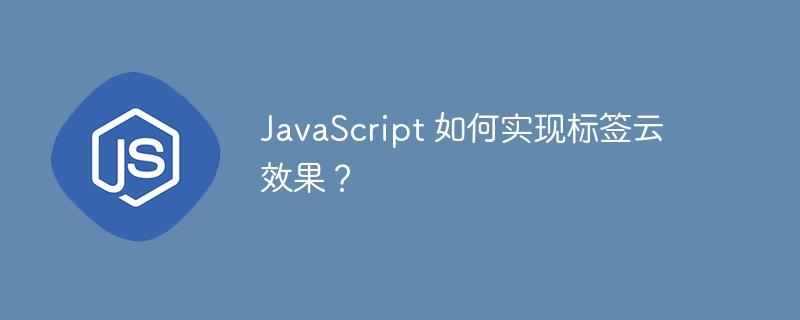Home >Web Front-end >JS Tutorial >How to implement tag cloud effect in JavaScript?
How to implement tag cloud effect in JavaScript?
- WBOYWBOYWBOYWBOYWBOYWBOYWBOYWBOYWBOYWBOYWBOYWBOYWBOriginal
- 2023-10-21 09:43:411160browse

How to achieve tag cloud effect in JavaScript?
The tag cloud effect is a common web design element that can show the importance and popularity of different tags. By using JavaScript, we can implement a simple yet effective tag cloud effect.
1. HTML structure
First, we need to create a container element in HTML to store the tag cloud. For example, we can create a div element with the id "tag-cloud". Then, add some label elements inside this container element. For example:
<div id="tag-cloud"> <span>JavaScript</span> <span>HTML</span> <span>CSS</span> <span>Python</span> <span>Java</span> <span>PHP</span> </div>
2. CSS styles
Next, we need to add some basic CSS styles to the tag cloud. For example, we can set the size, color and layout of the tags:
#tag-cloud {
display: flex;
flex-wrap: wrap;
justify-content: center;
align-items: center;
}
#tag-cloud span {
padding: 4px 8px;
margin: 4px;
font-size: 16px;
background-color: #f2f2f2;
border-radius: 4px;
color: #333;
}
#tag-cloud span:hover {
background-color: #555;
color: #fff;
cursor: pointer;
}3. JavaScript implementation
Next, we need to use JavaScript to achieve the tag cloud effect. The specific steps are as follows:
- Get the reference of the tag cloud container:
var tagCloud = document.getElementById("tag-cloud");- Get the reference of the tag element and add a click event for each tag:
var tags = tagCloud.getElementsByTagName("span");
for (var i = 0; i < tags.length; i++) {
tags[i].addEventListener("click", function() {
// 处理标签点击事件
});
}- In the label click event, modify the label style to show the click effect. For example, we can change the background color of the clicked tag to blue and the background color of other tags to gray:
for (var j = 0; j < tags.length; j++) {
tags[j].style.backgroundColor = "#f2f2f2";
tags[j].style.color = "#333";
}
this.style.backgroundColor = "blue";
this.style.color = "#fff";- Finally, we can add a Mouse move event to add hover effect:
tagCloud.addEventListener("mouseover", function(e) {
if (e.target.tagName === "SPAN") {
e.target.style.backgroundColor = "#555";
e.target.style.color = "#fff";
}
});
tagCloud.addEventListener("mouseout", function(e) {
if (e.target.tagName === "SPAN") {
e.target.style.backgroundColor = "#f2f2f2";
e.target.style.color = "#333";
}
});Summary
Through the above steps, we successfully implemented a simple tag cloud effect. In actual development, you can also modify JavaScript code and CSS styles as needed to achieve more complex effects. I hope this article can help you understand and use JavaScript to achieve tag cloud effects.
The above is the detailed content of How to implement tag cloud effect in JavaScript?. For more information, please follow other related articles on the PHP Chinese website!
Related articles
See more- An in-depth analysis of the Bootstrap list group component
- Detailed explanation of JavaScript function currying
- Complete example of JS password generation and strength detection (with demo source code download)
- Angularjs integrates WeChat UI (weui)
- How to quickly switch between Traditional Chinese and Simplified Chinese with JavaScript and the trick for websites to support switching between Simplified and Traditional Chinese_javascript skills

